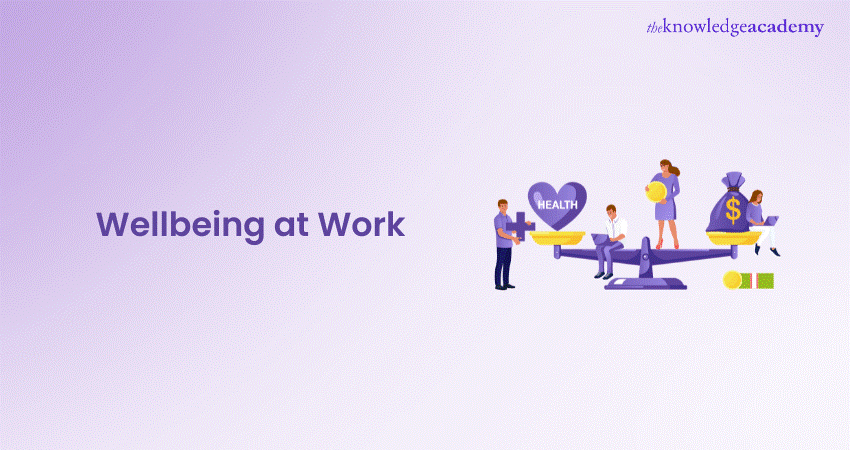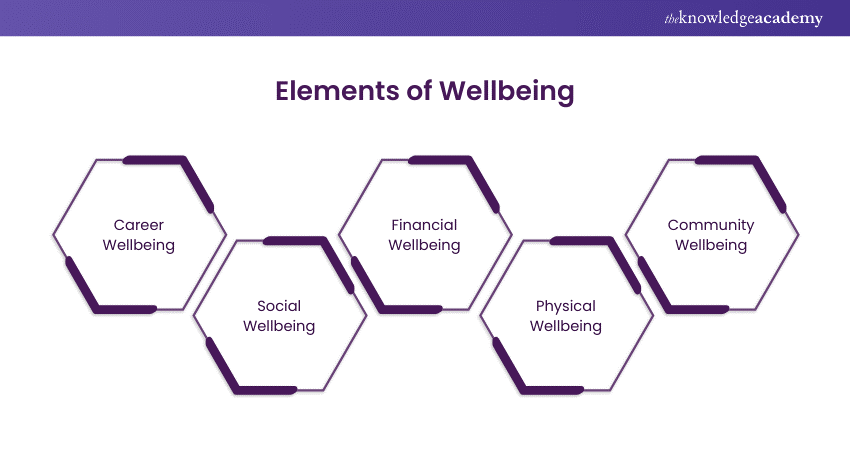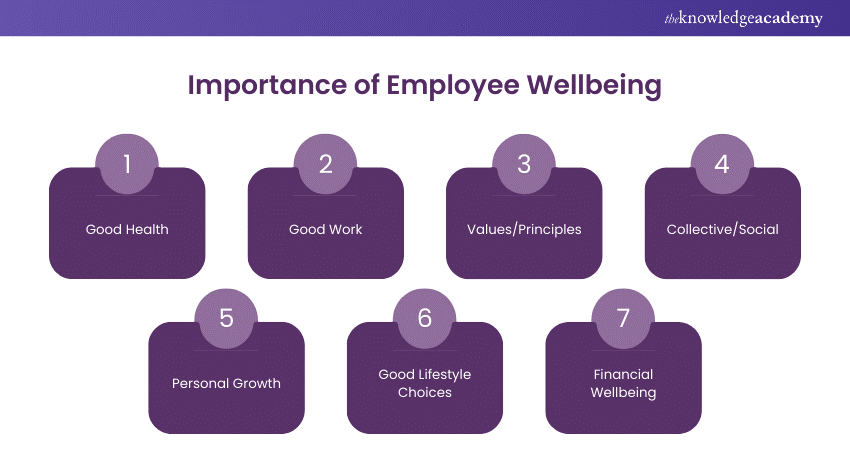We may not have the course you’re looking for. If you enquire or give us a call on +44 1344 203 999 and speak to our training experts, we may still be able to help with your training requirements.
Training Outcomes Within Your Budget!
We ensure quality, budget-alignment, and timely delivery by our expert instructors.

Have you ever walked into your workplace and felt an immediate sense of ease and satisfaction? Or have you wondered why some organisations seem to have happier, more productive employees than others? The answer often lies in a simple yet profound concept: Wellbeing at Work. In this blog, discover actionable insights and tips for creating a vibrant, supportive, and productive work environment.
So, what does it take to cultivate Wellbeing at Work? What strategies can leaders implement to ensure their teams are thriving on all fronts? Join us as we delve into the core values and elements that define Wellbeing at Workplace. Are you ready to transform your workplace into a haven of wellbeing? Let's get started!
Table of Contents
1) What is Wellbeing?
2) The Elements of Wellbeing
3) The Value of Employee Wellbeing
4) Measuring the Impact of Workplace Wellbeing Initiatives
5) Conclusion
What is Wellbeing?
Wellbeing is a broad concept that includes the overall quality of an individual's life, touching on physical, mental, emotional, and social health. In the workplace, wellbeing refers to the comprehensive state of employees' health and satisfaction. This includes their physical and mental health, work-life balance, and the quality of their professional and social interactions.
It involves ensuring that employees feel valued, supported, and engaged. Promoting Wellbeing at Work is vital for fostering a positive, productive, and sustainable work environment. It leads to enhanced employee satisfaction, reduced absenteeism, and increased overall productivity. It creates a workplace culture where employees can thrive both personally and professionally.
The Elements of Wellbeing
Each element represents a vital aspect of life that individuals can actively improve:

1) Career Wellbeing: You enjoy your daily work
2) Social Wellbeing: You have meaningful friendships
3) Financial Wellbeing: You manage your finances effectively
4) Physical Wellbeing: You have the energy to accomplish tasks
5) Community Wellbeing: You are satisfied with where you live
Career Wellbeing Action Items for Leaders
To enhance career wellbeing, leaders can take specific actions that create a supportive and productive work environment. Here are some key strategies:
1) Help Employees Discover Their Strengths: Assist employees in identifying and leveraging their strengths. Use a strengths-based strategy to design the employee experience, from attraction to performance.
2) Eliminate Abusive Managers: Do not tolerate managers who make employees' lives miserable. Such managers pose a significant risk to overall wellbeing.
3) Develop Managers as Coaches: Shift the managerial mindset from being a boss to being a coach. Encourage managers to develop employee performance through regular coaching conversations and meaningful feedback.
4) Incorporate Wellbeing into Career Development Conversations: Foster a bond of trust between managers and teams to facilitate meaningful discussions about Wellbeing at Work.
How Does Mental Wellbeing Factor in?
Mental wellbeing is fundamental to an individual's overall health and productivity. At work, mental wellbeing can be influenced by factors such as workload, stress levels, workplace culture, and support systems. To foster mental wellbeing, organisations should:
1) Promote a culture of openness and support regarding mental health
2) Make resources and support services for mental health accessible
3) Implement stress management programs
4) Encourage regular breaks and mindfulness practices
5) Foster a supportive and inclusive workplace environment
Join our Health And Safety In The Workplace Training to create a safer, more productive work environment!
The Value of Employee Wellbeing
Investing in employee wellbeing offers numerous benefits for both employees and organisations. A holistic approach to wellbeing can enhance health, job satisfaction, and productivity. The key values of employee wellbeing include:

1) Good Health
Health is the foundation of wellbeing. Employees in good health are more engaged, productive, and less likely to miss work. Employers can promote health by focusing on physical, mental, and safety aspects:
a) Physical Health: Implement health promotion activities, regular health checks, and wellbeing benefits, including health insurance and disability management. Provide Occupational Health (OH) support and Employee Assistance Programs (EAP). Encourage physical activity and healthy eating through wellness programs and nutritious food options.
b) Physical Safety: Ensure safe working practices, provide safe equipment, and offer personal safety training to create a secure and ergonomic working environment.
c) Mental Health: Promote stress management, conduct risk assessments, offer conflict resolution training, and train line managers to handle difficult conversations. Provide support for managing mental ill health through OH support and EAP.
2) Good Work
Good work involves meaningful, engaging, and satisfying job roles, with a clear understanding of responsibilities, growth opportunities, and a sense of purpose. Employers can promote good work by focusing on several key areas:
a) Working Environment: Design ergonomically sound workspaces and cultivate an open, inclusive culture.
b) Effective Line Management: Implement strong people management policies, provide training for line managers, and manage sickness absence effectively.
c) Work Demands: Design jobs that align with employees' skills and interests, ensuring clear roles, quality work, manageable workloads, reasonable working hours, job satisfaction, and work-life balance.
d) Autonomy: Grant employees control over their work, foster innovation, and protect whistleblowers.
e) Change Management: Maintain effective communication, involve employees in decision-making, and demonstrate strong leadership.
f) Pay and Reward: Ensure fair and transparent remuneration practices and offer non-financial recognition.
3) Values/Principles
A values-driven workplace fosters trust, respect, and integrity. Employees who feel their personal values align with their company's values are more likely to be engaged and committed. To promote values and principles, employers should focus on:
a) Leadership: Practice values-based leadership with a clear mission and objectives. Develop a health and wellbeing strategy, uphold corporate governance, and build trust.
b) Ethical Standards: Maintain respect at work, embrace corporate social responsibility, invest in the community, and encourage volunteering.
c) Inclusion and Diversity: Value differences, promote cultural engagement, and provide training for employees and managers.
d) Communication and Recognition: Clearly communicate the organisation's values and principles, embed these values into everyday practices and policies, and recognise and reward behaviours that align with organisational values.
4) Collective/Social
Social Wellbeing at Work involves fostering strong interpersonal relationships and a sense of community. It can be promoted by focusing on several key areas:
a) Employee Voice: Encourage open communication, consultation, genuine dialogue, and involvement in decision-making.
b) Positive Relationships: Cultivate a supportive management style, promote teamwork, and build healthy relationships with peers and managers, ensuring dignity and respect.
c) Teamwork and Collaboration: Encourage teamwork and collaboration through organised social events and team-building activities.
d) Opportunities for Engagement: Create opportunities for employees to create a connection and participate, developing a sense of community within the workplace.
5) Personal Growth
Personal growth is essential for long-term satisfaction and motivation. It encompasses opportunities for learning, skill development, and career progression. Employers can support personal growth by focusing on several key areas:
a) Career Development: Offer mentoring, coaching, performance management, development plans, skill utilisation, and succession planning.
b) Training and Development: Provide training and development programs, access to lifelong learning opportunities, mid-career reviews, and technical and vocational learning.
c) Emotional Wellbeing: Foster positive relationships, offer resilience training, and support financial wellbeing.
d) Creativity: Encourage an open and collaborative culture through innovation workshops.
e) Goal Setting: Encourage employees to set and pursue personal and professional goals, supporting their growth and development.
6) Good Lifestyle Choices
Promoting good lifestyle choices involves encouraging healthy habits both inside and outside of work. Employers can support this by focusing on several key areas:
a) Physical Activity: Offer walking clubs, lunchtime yoga sessions, and organise charity walks to promote physical fitness.
b) Healthy Eating: Provide healthy menu choices in the canteen and establish recipe clubs to encourage nutritious eating habits.
c) Resources and Support: Offer resources and support for healthy living, including programs on nutrition, fitness, and mental health.
d) Work-Life Balance: Encourage work-life balance and effective time management to help employees maintain a healthy lifestyle.
7) Financial Wellbeing
Financial wellbeing is an important aspect of overall wellbeing. Employees who feel financially secure are less stressed and more productive. Employers can support financial wellbeing by focusing on several key areas:
a) Fair Pay and Benefits: Offer fair and competitive salaries, ensuring pay rates are above the statutory National Minimum/Living Wage, and provide a flexible benefits scheme.
b) Retirement Planning: Provide phased retirement options, such as three- or four-day weeks, and offer pre-retirement courses to help employees plan for their future.
c) Financial Education and Support: Offer financial education and planning resources, including access to independent financial advisers. Provide Employee Assistance Programs (EAP) that offer debt counselling and signposting to external free advice, such as Citizens Advice.
Transform your workplace with Healthy Working Environment Training and boost safety, productivity, and employee wellbeing!
Measuring the Impact of Workplace Wellbeing Initiatives
Measuring the impact of wellbeing initiatives is crucial for understanding their effectiveness and making necessary improvements. Key metrics to consider include:
a) Employee engagement and satisfaction scores
b) Health and wellness program participation rates
c) Absenteeism and turnover rates
d) Productivity and performance metrics
e) Feedback from employee surveys and focus groups
Ensure workplace safety and preparedness with a comprehensive First Aid At Work Course - learn skills to save lives today!
Conclusion
Prioritising Wellbeing at Work fosters a healthier, happier, and more productive environment. By implementing the strategies discussed, leaders can create a supportive atmosphere where employees thrive. Transform your workplace into a sanctuary of wellbeing, enhancing overall satisfaction and organisational success. Start today and witness the positive impact.
Elevate your workplace safety standards – register for our Health & Safety in the Workplace Training for a healthier, more productive work environment!
Frequently Asked Questions

Leaders can promote wellbeing by implementing various strategies. These include offering health and wellness programs and fostering a positive workplace culture. Additionally, giving opportunities for personal and professional growth and ensuring fair pay and benefits are crucial.

Leaders can promote wellbeing by implementing various strategies. These include offering health and wellness programs and fostering a positive workplace culture. Additionally, giving opportunities for personal and professional growth and ensuring fair pay and benefits are crucial.

The Knowledge Academy takes global learning to new heights, offering over 30,000 online courses across 490+ locations in 220 countries. This expansive reach ensures accessibility and convenience for learners worldwide.
Alongside our diverse Online Course Catalogue, encompassing 17 major categories, we go the extra mile by providing a plethora of free educational Online Resources like News updates, Blogs, videos, webinars, and interview questions. Tailoring learning experiences further, professionals can maximise value with customisable Course Bundles of TKA.

The Knowledge Academy’s Knowledge Pass, a prepaid voucher, adds another layer of flexibility, allowing course bookings over a 12-month period. Join us on a journey where education knows no bounds.

The Knowledge Academy offers various Health & Safety in the Workplace, including First Aid At Work, Healthy Working Environment Training and Health and Safety Training for Managers and Supervisors. These courses cater to different skill levels, providing comprehensive insights into Workplace Safety Tips.
Our Health & Safety Blogs cover a range of topics related to Health and Safety, offering valuable resources, best practices, and industry insights. Whether you are a beginner or looking to advance your knowledge of Health and Safety, The Knowledge Academy's diverse courses and informative blogs have got you covered.
Upcoming Health & Safety Resources Batches & Dates
Date
 First Aid at Work
First Aid at Work
Fri 13th Dec 2024
Fri 17th Jan 2025
Fri 21st Feb 2025
Fri 4th Apr 2025
Fri 6th Jun 2025
Fri 25th Jul 2025
Fri 7th Nov 2025
Fri 26th Dec 2025







 Top Rated Course
Top Rated Course



 If you wish to make any changes to your course, please
If you wish to make any changes to your course, please


